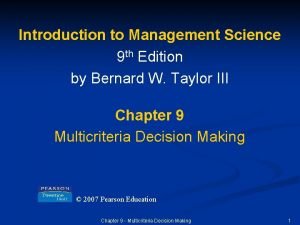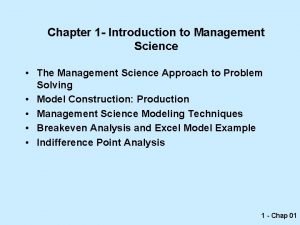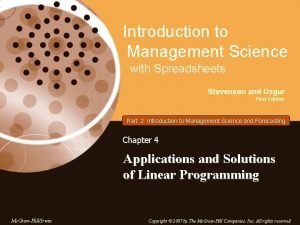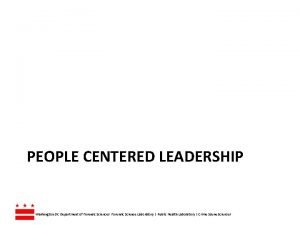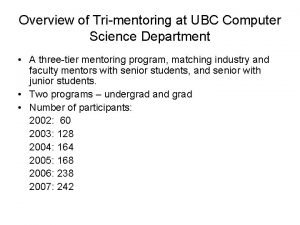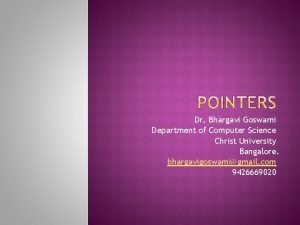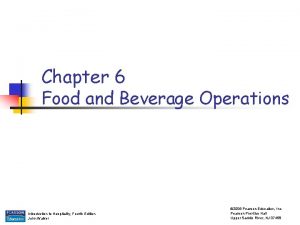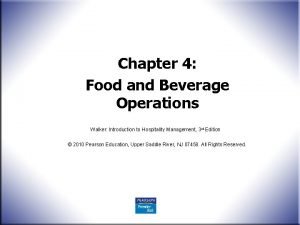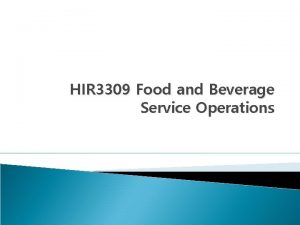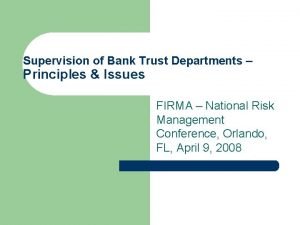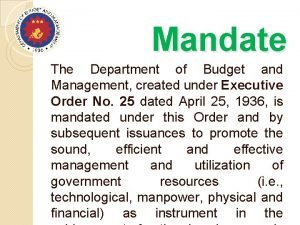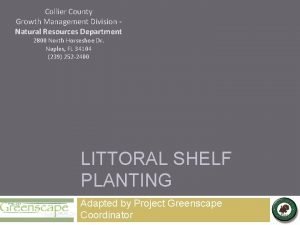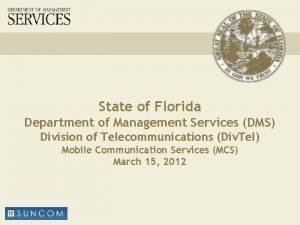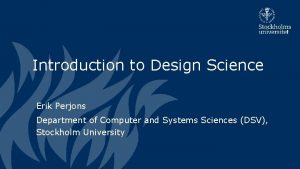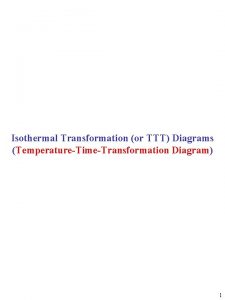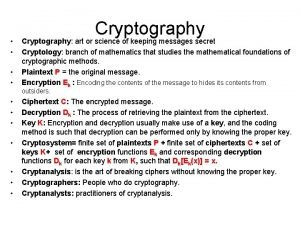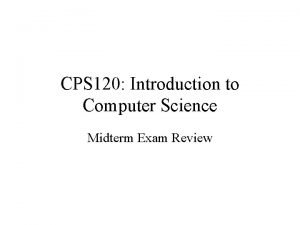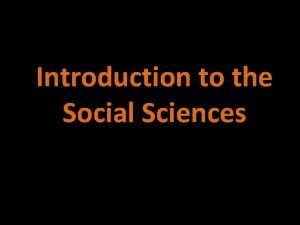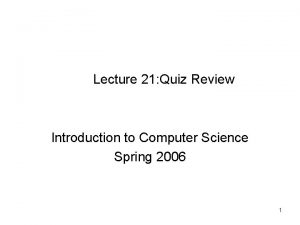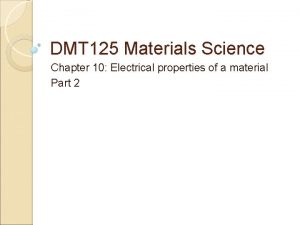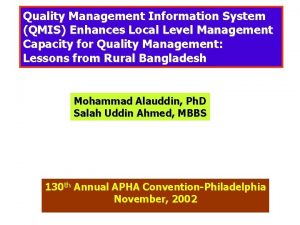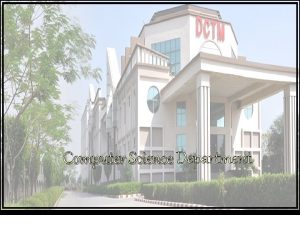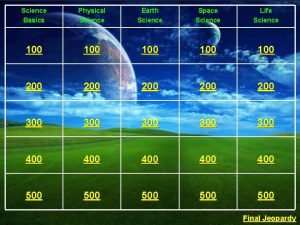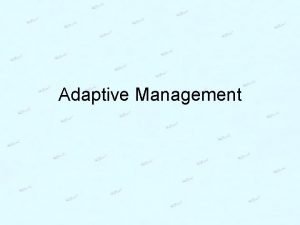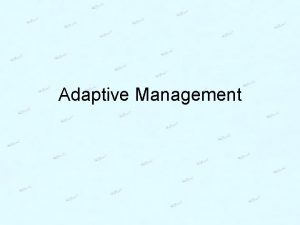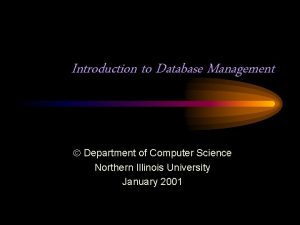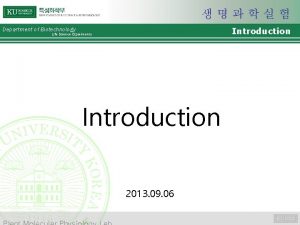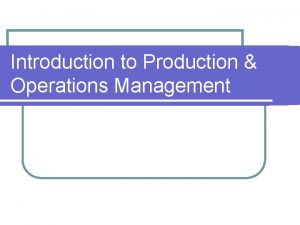Department of QMIS Introduction to Management Science QMIS

























































- Slides: 57

Department of QMIS Introduction to Management Science QMIS 205 © 2011 Cengage Learning. All Rights Reserved. May not be scanned, copied or duplicated, or posted to a publicly accessible website, in whole or in part. Slide

Chapter 1 Introduction n n n Body of Knowledge Problem Solving and Decision Making Quantitative Analysis Models of Cost, Revenue, and Profit Quantitative Methods in Practice © 2011 Cengage Learning. All Rights Reserved. May not be scanned, copied or duplicated, or posted to a publicly accessible website, in whole or in part. Slide 2

Body of Knowledge n n The body of knowledge involving quantitative approaches to decision making is referred to as • Management Science • Operations Research • Decision Science It had its early roots in World War II and is flourishing in business and industry due, in part, to: • numerous methodological developments (e. g. simplex method for solving linear programming problems) • a virtual explosion in computing power © 2011 Cengage Learning. All Rights Reserved. May not be scanned, copied or duplicated, or posted to a publicly accessible website, in whole or in part. Slide 3

Problem Solving and Decision Making n 7 Steps of Problem Solving (First 5 steps are the process of decision making) 1. Identify and define the problem. 2. Determine the set of alternative solutions. 3. Determine the criteria for evaluating alternatives. 4. Evaluate the alternatives. 5. Choose an alternative (make a decision). ----------------------------------6. Implement the selected alternative. 7. Evaluate the results. © 2011 Cengage Learning. All Rights Reserved. May not be scanned, copied or duplicated, or posted to a publicly accessible website, in whole or in part. Slide 4

Quantitative Analysis and Decision Making n Decision-Making Process Structuring the Problem Define the Problem Identify the Alternatives Determine the Criteria Analyzing the Problem Identify the Alternatives Choose an Alternative • Problems in which the objective is to find the best solution with respect to one criterion are referred to as singlecriterion decision problems. • Problems that involve more than one criterion are referred to as multicriteria decision problems. © 2011 Cengage Learning. All Rights Reserved. May not be scanned, copied or duplicated, or posted to a publicly accessible website, in whole or in part. Slide 5

Quantitative Analysis and Decision Making n Analysis Phase of Decision-Making Process Qualitative Analysis • based largely on the manager’s judgment and experience • includes the manager’s intuitive “feel” for the problem • is more of an art than a science © 2011 Cengage Learning. All Rights Reserved. May not be scanned, copied or duplicated, or posted to a publicly accessible website, in whole or in part. Slide 6

Quantitative Analysis and Decision Making n Analysis Phase of Decision-Making Process Quantitative Analysis • analyst will concentrate on the quantitative facts or data associated with the problem • analyst will develop mathematical expressions that describe the objectives, constraints, and other relationships that exist in the problem • analyst will use one or more quantitative methods to make a recommendation © 2011 Cengage Learning. All Rights Reserved. May not be scanned, copied or duplicated, or posted to a publicly accessible website, in whole or in part. Slide 7

Quantitative Analysis and Decision Making n Potential Reasons for a Quantitative Analysis Approach to Decision Making • The problem is complex. • The problem is very important. • The problem is new. • The problem is repetitive. © 2011 Cengage Learning. All Rights Reserved. May not be scanned, copied or duplicated, or posted to a publicly accessible website, in whole or in part. Slide 8

Quantitative Analysis n Quantitative Analysis Process • Model Development • Data Preparation • Model Solution • Report Generation © 2011 Cengage Learning. All Rights Reserved. May not be scanned, copied or duplicated, or posted to a publicly accessible website, in whole or in part. Slide 9

Model Development n n Models are representations of real objects or situations Three forms of models are: • Iconic models - physical replicas (scalar representations) of real objects • Analog models - physical in form, but do not physically resemble the object being modeled • Mathematical models - represent real world problems through a system of mathematical formulas and expressions based on key assumptions, estimates, or statistical analyses © 2011 Cengage Learning. All Rights Reserved. May not be scanned, copied or duplicated, or posted to a publicly accessible website, in whole or in part. Slide 10

Advantages of Models n n Generally, experimenting with models (compared to experimenting with the real situation): • requires less time • is less expensive • involves less risk The more closely the model represents the real situation, the accurate the conclusions and predictions will be. © 2011 Cengage Learning. All Rights Reserved. May not be scanned, copied or duplicated, or posted to a publicly accessible website, in whole or in part. Slide 11

Mathematical Models n Objective Function – a mathematical expression that describes the problem’s objective, such as maximizing profit or minimizing cost • Consider a simple production problem. Suppose x denotes the number of units produced and sold each week, and the firm’s objective is to maximize total weekly profit. With a profit of $10 per unit, the objective function is 10 x. © 2011 Cengage Learning. All Rights Reserved. May not be scanned, copied or duplicated, or posted to a publicly accessible website, in whole or in part. Slide 12

Mathematical Models n Constraints – a set of restrictions or limitations, such as production capacities n To continue our example, a production capacity constraint would be necessary if, for instance, 5 hours are required to produce each unit and only 40 hours are available per week. The production capacity constraint is given by 5 x < 40. n The value of 5 x is the total time required to produce x units; the symbol indicates that the production time required must be less than or equal to the 40 hours available. © 2011 Cengage Learning. All Rights Reserved. May not be scanned, copied or duplicated, or posted to a publicly accessible website, in whole or in part. Slide 13

Mathematical Models n Uncontrollable Inputs – environmental factors that are not under the control of the decision maker n In the preceding mathematical model, the profit per unit ($10), the production time per unit (5 hours), and the production capacity (40 hours) are environmental factors not under the control of the manager or decision maker. © 2011 Cengage Learning. All Rights Reserved. May not be scanned, copied or duplicated, or posted to a publicly accessible website, in whole or in part. Slide 14

Mathematical Models n Decision Variables – controllable inputs; decision alternatives specified by the decision maker, such as the number of units of a product to produce. n In the preceding mathematical model, the production quantity x is the controllable input to the model. © 2011 Cengage Learning. All Rights Reserved. May not be scanned, copied or duplicated, or posted to a publicly accessible website, in whole or in part. Slide 15

Mathematical Models n A complete mathematical model for our simple production problem is: Maximize subject to: 10 x (objective function) 5 x < 40 (constraint) x>0 (constraint) [The second constraint reflects the fact that it is not possible to manufacture a negative number of units. ] © 2011 Cengage Learning. All Rights Reserved. May not be scanned, copied or duplicated, or posted to a publicly accessible website, in whole or in part. Slide 16

Mathematical Models n n n Deterministic Model – if all uncontrollable inputs to the model are known and cannot vary Stochastic (or Probabilistic) Model – if any uncontrollable are uncertain and subject to variation Stochastic models are often more difficult to analyze. n In our simple production example, if the number of hours of production time per unit could vary from 3 to 6 hours depending on the quality of the raw material, the model would be stochastic. © 2011 Cengage Learning. All Rights Reserved. May not be scanned, copied or duplicated, or posted to a publicly accessible website, in whole or in part. Slide 17

Mathematical Models n n Cost/benefit considerations must be made in selecting an appropriate mathematical model. Frequently a less complicated (and perhaps less precise) model is more appropriate than a more complex and accurate one due to cost and ease of solution considerations. © 2011 Cengage Learning. All Rights Reserved. May not be scanned, copied or duplicated, or posted to a publicly accessible website, in whole or in part. Slide 18

Transforming Model Inputs into Output Uncontrollable Inputs (Environmental Factors) Controllable Inputs (Decision Variables) Mathematical Model © 2011 Cengage Learning. All Rights Reserved. May not be scanned, copied or duplicated, or posted to a publicly accessible website, in whole or in part. Output (Projected Results) Slide 19

Data Preparation n n Data preparation is not a trivial step, due to the time required and the possibility of data collection errors. A model with 50 decision variables and 25 constraints could have over 1300 data elements! Often, a fairly large data base is needed. Information systems specialists might be needed. © 2011 Cengage Learning. All Rights Reserved. May not be scanned, copied or duplicated, or posted to a publicly accessible website, in whole or in part. Slide 20

Model Solution n n The analyst attempts to identify the alternative (the set of decision variable values) that provides the “best” output for the model. The “best” output is the optimal solution. If the alternative does not satisfy all of the model constraints, it is rejected as being infeasible, regardless of the objective function value. If the alternative satisfies all of the model constraints, it is feasible and a candidate for the “best” solution. © 2011 Cengage Learning. All Rights Reserved. May not be scanned, copied or duplicated, or posted to a publicly accessible website, in whole or in part. Slide 21

Model Solution § Trial-and-Error Solution for Production Problem Production Quantity 0 2 4 6 8 10 12 Projected Profit 0 20 40 60 80 100 120 Total Hours of Production 0 10 20 30 40 50 60 © 2011 Cengage Learning. All Rights Reserved. May not be scanned, copied or duplicated, or posted to a publicly accessible website, in whole or in part. Feasible Solution Yes Yes Yes No No Slide 22

Model Solution n A variety of software packages are available for solving mathematical models. • Microsoft Excel • LINGO © 2011 Cengage Learning. All Rights Reserved. May not be scanned, copied or duplicated, or posted to a publicly accessible website, in whole or in part. Slide 23

Model Testing and Validation n n Often, goodness/accuracy of a model cannot be assessed until solutions are generated. Small test problems having known, or at least expected, solutions can be used for model testing and validation. If the model generates expected solutions, use the model on the full-scale problem. If inaccuracies or potential shortcomings inherent in the model are identified, take corrective action such as: • Collection of more-accurate input data • Modification of the model © 2011 Cengage Learning. All Rights Reserved. May not be scanned, copied or duplicated, or posted to a publicly accessible website, in whole or in part. Slide 24

Report Generation n A managerial report, based on the results of the model, should be prepared. The report should be easily understood by the decision maker. The report should include: • the recommended decision • other pertinent information about the results (for example, how sensitive the model solution is to the assumptions and data used in the model) © 2011 Cengage Learning. All Rights Reserved. May not be scanned, copied or duplicated, or posted to a publicly accessible website, in whole or in part. Slide 25

Implementation and Follow-Up n n Successful implementation of model results is of critical importance. Secure as much user involvement as possible throughout the modeling process. Continue to monitor the contribution of the model. It might be necessary to refine or expand the model. © 2011 Cengage Learning. All Rights Reserved. May not be scanned, copied or duplicated, or posted to a publicly accessible website, in whole or in part. Slide 26

Models of Cost, Revenue, and Profit Iron Works, Inc. manufactures two products made from steel and just received this month's allocation of b pounds of steel. It takes a 1 pounds of steel to make a unit of product 1 and a 2 pounds of steel to make a unit of product 2. Let x 1 and x 2 denote this month's production level of product 1 and product 2, respectively. Denote by p 1 and p 2 the unit profits for products 1 and 2, respectively. Iron Works has a contract calling for at least m units of product 1 this month. The firm's facilities are such that at most u units of product 2 may be produced monthly. © 2011 Cengage Learning. All Rights Reserved. May not be scanned, copied or duplicated, or posted to a publicly accessible website, in whole or in part. Slide 27

Example: Iron Works, Inc. n Mathematical Model • The total monthly profit = (profit per unit of product 1) x (monthly production of product 1) + (profit per unit of product 2) x (monthly production of product 2) = p 1 x 1 + p 2 x 2 We want to maximize total monthly profit: Max p 1 x 1 + p 2 x 2 © 2011 Cengage Learning. All Rights Reserved. May not be scanned, copied or duplicated, or posted to a publicly accessible website, in whole or in part. Slide 28

Example: Iron Works, Inc. n Mathematical Model (continued) • The total amount of steel used during monthly production equals: (steel required per unit of product 1) x (monthly production of product 1) + (steel required per unit of product 2) x (monthly production of product 2) = a 1 x 1 + a 2 x 2 This quantity must be less than or equal to the allocated b pounds of steel: a 1 x 1 + a 2 x 2 < b © 2011 Cengage Learning. All Rights Reserved. May not be scanned, copied or duplicated, or posted to a publicly accessible website, in whole or in part. Slide 29

Example: Iron Works, Inc. n Mathematical Model (continued) • The monthly production level of product 1 must be greater than or equal to m : x 1 > m • The monthly production level of product 2 must be less than or equal to u : x 2 < u • However, the production level for product 2 cannot be negative: x 2 > 0 © 2011 Cengage Learning. All Rights Reserved. May not be scanned, copied or duplicated, or posted to a publicly accessible website, in whole or in part. Slide 30

Example: Iron Works, Inc. n Mathematical Model Summary Objective Function Max p 1 x 1 + p 2 x 2 s. t. a 1 x 1 + a 2 x 2 < b x 1 > m x 2 < u x 2 > 0 Constraints “Subject to” © 2011 Cengage Learning. All Rights Reserved. May not be scanned, copied or duplicated, or posted to a publicly accessible website, in whole or in part. Slide 31

Example: Iron Works, Inc. n Question: Suppose b = 2000, a 1 = 2, a 2 = 3, m = 60, u = 720, p 1 = 100, p 2 = 200. Rewrite the model with these specific values for the uncontrollable inputs. © 2011 Cengage Learning. All Rights Reserved. May not be scanned, copied or duplicated, or posted to a publicly accessible website, in whole or in part. Slide 32

Example: Iron Works, Inc. n Answer: Substituting, the model is: Max 100 x 1 + 200 x 2 s. t. 2 x 1 + 3 x 2 < 2000 x 1 > 60 x 2 < 720 x 2 > 0 © 2011 Cengage Learning. All Rights Reserved. May not be scanned, copied or duplicated, or posted to a publicly accessible website, in whole or in part. Slide 33

Example: Iron Works, Inc. n n Question: The optimal solution to the current model is x 1 = 60 and x 2 = 626 2/3. If the product were engines, explain why this is not a true optimal solution for the "real-life" problem. Answer: One cannot produce and sell 2/3 of an engine. Thus the problem is further restricted by the fact that both x 1 and x 2 must be integers. (They could remain fractions if it is assumed these fractions are work in progress to be completed the next month. ) © 2011 Cengage Learning. All Rights Reserved. May not be scanned, copied or duplicated, or posted to a publicly accessible website, in whole or in part. Slide 34

Example: Iron Works, Inc. Uncontrollable Inputs $100 profit per unit Prod. 1 $200 profit per unit Prod. 2 2 lbs. steel per unit Prod. 1 3 lbs. Steel per unit Prod. 2 2000 lbs. steel allocated 60 units minimum Prod. 1 720 units maximum Prod. 2 0 units minimum Prod. 2 60 units Prod. 1 626. 67 units Prod. 2 Controllable Inputs Max 100(60) + 200(626. 67) s. t. 2(60) + 3(626. 67) < 2000 60 > 60 626. 67 < 720 626. 67 > 0 Profit = $131, 333. 33 Steel Used = 2000 Output Mathematical Model © 2011 Cengage Learning. All Rights Reserved. May not be scanned, copied or duplicated, or posted to a publicly accessible website, in whole or in part. Slide 35

Example: Ponderosa Development Corporation (PDC) is a small real estate developer that builds only one style house. The selling price of the house is $115, 000. Land for each house costs $55, 000 and lumber, supplies, and other materials run another $28, 000 per house. Total labor costs are approximately $20, 000 per house. © 2011 Cengage Learning. All Rights Reserved. May not be scanned, copied or duplicated, or posted to a publicly accessible website, in whole or in part. Slide 36

Example: Ponderosa Development Corp. Ponderosa leases office space for $2, 000 per month. The cost of supplies, utilities, and leased equipment runs another $3, 000 per month. The one salesperson of PDC is paid a commission of $2, 000 on the sale of each house. PDC has seven permanent office employees whose monthly salaries are given on the next slide. © 2011 Cengage Learning. All Rights Reserved. May not be scanned, copied or duplicated, or posted to a publicly accessible website, in whole or in part. Slide 37

Example: Ponderosa Development Corp. Employee Monthly Salary President $10, 000 VP, Development 6, 000 VP, Marketing 4, 500 Project Manager 5, 500 Controller 4, 000 Office Manager 3, 000 Receptionist 2, 000 © 2011 Cengage Learning. All Rights Reserved. May not be scanned, copied or duplicated, or posted to a publicly accessible website, in whole or in part. Slide 38

Example: Ponderosa Development Corp. n n Question: Identify all costs and denote the marginal cost and marginal revenue for each house. Answer: The monthly salaries total $35, 000 and monthly office lease and supply costs total another $5, 000. This $40, 000 is a monthly fixed cost. The total cost of land, material, labor, and sales commission per house, $105, 000, is the marginal cost for a house. The selling price of $115, 000 is the marginal revenue per house. © 2011 Cengage Learning. All Rights Reserved. May not be scanned, copied or duplicated, or posted to a publicly accessible website, in whole or in part. Slide 39

Example: Ponderosa Development Corp. n n Question: Write the monthly cost function c (x), revenue function r (x), and profit function p (x). Answer: c (x) = variable cost + fixed cost = 105, 000 x + 40, 000 r (x) = 115, 000 x p (x) = r (x) - c (x) = 10, 000 x - 40, 000 © 2011 Cengage Learning. All Rights Reserved. May not be scanned, copied or duplicated, or posted to a publicly accessible website, in whole or in part. Slide 40

Example: Ponderosa Development Corp. n n Question: What is the breakeven point for monthly sales of the houses? Answer: r (x ) = c (x ) 115, 000 x = 105, 000 x + 40, 000 Solving, x = 4. © 2011 Cengage Learning. All Rights Reserved. May not be scanned, copied or duplicated, or posted to a publicly accessible website, in whole or in part. Slide 41

Example: Ponderosa Development Corp. n n Question: What is the monthly profit if 12 houses per month are built and sold? Answer: p (12) = 10, 000(12) - 40, 000 = $80, 000 monthly profit © 2011 Cengage Learning. All Rights Reserved. May not be scanned, copied or duplicated, or posted to a publicly accessible website, in whole or in part. Slide 42

Example: Ponderosa Development Corp. Thousands of Dollars 1200 Total Revenue = 115, 000 x 1000 800 600 Total Cost = 40, 000 + 105, 000 x 400 200 Break-Even Point = 4 Houses 0 0 1 2 3 4 5 6 7 8 Number of Houses Sold (x) © 2011 Cengage Learning. All Rights Reserved. May not be scanned, copied or duplicated, or posted to a publicly accessible website, in whole or in part. 9 10 Slide 43

Using Excel for Breakeven Analysis n n n A spreadsheet software package such as Microsoft Excel can be used to perform a quantitative analysis of Ponderosa Development Corporation. We will enter the problem data in the top portion of the spreadsheet. The bottom of the spreadsheet will be used for model development. © 2011 Cengage Learning. All Rights Reserved. May not be scanned, copied or duplicated, or posted to a publicly accessible website, in whole or in part. Slide 44

Example: Ponderosa Development Corp. n Formula Spreadsheet © 2011 Cengage Learning. All Rights Reserved. May not be scanned, copied or duplicated, or posted to a publicly accessible website, in whole or in part. Slide 45

Example: Ponderosa Development Corp. n Question What is the monthly profit if 12 houses are built and sold per month? © 2011 Cengage Learning. All Rights Reserved. May not be scanned, copied or duplicated, or posted to a publicly accessible website, in whole or in part. Slide 46

Example: Ponderosa Development Corp. n Spreadsheet Solution © 2011 Cengage Learning. All Rights Reserved. May not be scanned, copied or duplicated, or posted to a publicly accessible website, in whole or in part. Slide 47

Example: Ponderosa Development Corp. n n Question: What is the breakeven point for monthly sales of the houses? Spreadsheet Solution: • One way to determine the break-even point using a spreadsheet is to use the Goal Seek tool. • Microsoft Excel ‘s Goal Seek tool allows the user to determine the value for an input cell that will cause the output cell to equal some specified value. • In our case, the goal is to set Total Profit to zero by seeking an appropriate value for Sales Volume. © 2011 Cengage Learning. All Rights Reserved. May not be scanned, copied or duplicated, or posted to a publicly accessible website, in whole or in part. Slide 48

Example: Ponderosa Development Corp. n Spreadsheet Solution: Goal Seek Approach Using Excel ’s Goal Seek Tool Step 1: Select Data on menu Step 2: Choose What-If Analysis in Data Tools submenu Step 3: Choose the Goal Seek option Step 4: When the Goal Seek dialog box appears: Enter B 9 in the Set cell box Enter 0 in the To value box Enter B 6 in the By changing cell box Click OK © 2011 Cengage Learning. All Rights Reserved. May not be scanned, copied or duplicated, or posted to a publicly accessible website, in whole or in part. Slide 49

Example: Ponderosa Development Corp. n Spreadsheet Solution: Goal Seek Approach Completed Goal Seek Dialog Box © 2011 Cengage Learning. All Rights Reserved. May not be scanned, copied or duplicated, or posted to a publicly accessible website, in whole or in part. Slide 50

Example: Ponderosa Development Corp. n Spreadsheet Solution: Goal Seek Approach © 2011 Cengage Learning. All Rights Reserved. May not be scanned, copied or duplicated, or posted to a publicly accessible website, in whole or in part. Slide 51

Management Science Techniques n n n Linear Programming Integer Linear Programming PERT/CPM Inventory Models Waiting Line Models Simulation n n n Decision Analysis Goal Programming Analytic Hierarchy Process Forecasting Markov-Process Models Dynamic Programming © 2011 Cengage Learning. All Rights Reserved. May not be scanned, copied or duplicated, or posted to a publicly accessible website, in whole or in part. Slide 52

Management Science Techniques n n n Linear programming is a problem-solving approach developed for situations involving maximizing or minimizing a linear function subject to linear constraints that limit the degree to which the objective can be pursued. Integer linear programming is an approach used for problems that can be set up as linear programs with the additional requirement that some or all of the decision recommendations be integer values. Network models are specialized solution procedures for problems in transportation system design, information system design, project scheduling, …. . © 2011 Cengage Learning. All Rights Reserved. May not be scanned, copied or duplicated, or posted to a publicly accessible website, in whole or in part. Slide 53

Management Science Techniques n n Project scheduling: PERT (Program Evaluation and Review Technique) and CPM (Critical Path Method) help managers responsible for planning, scheduling, and controlling projects that consist of numerous separate jobs or tasks performed by a variety of departments, individuals, and so forth. Inventory models are used by managers faced with the dual problems of maintaining sufficient inventories to meet demand for goods and, at the same time, incurring the lowest possible inventory holding costs. © 2011 Cengage Learning. All Rights Reserved. May not be scanned, copied or duplicated, or posted to a publicly accessible website, in whole or in part. Slide 54

Management Science Techniques n n n Waiting line (or queuing) models help managers understand make better decisions concerning the operation of systems involving waiting lines. Simulation is a technique used to model the operation of a system. This technique employs a computer program to model the operation and perform simulation computations. Decision analysis can be used to determine optimal strategies in situations involving several decision alternatives and an uncertain or risk-filled pattern of future events. © 2011 Cengage Learning. All Rights Reserved. May not be scanned, copied or duplicated, or posted to a publicly accessible website, in whole or in part. Slide 55

Management Science Techniques n n Goal programming is a technique for solving multi-criteria decision problems, usually within the framework of linear programming. Analytic hierarchy process is a multi-criteria decisionmaking technique that permits the inclusion of subjective factors in arriving at a recommended decision. Forecasting methods are techniques that can be used to predict future aspects of a business operation. Markov-process models are useful in studying the evolution of certain systems over repeated trials (such as describing the probability that a machine, functioning in one period, will function or break down in another period). © 2011 Cengage Learning. All Rights Reserved. May not be scanned, copied or duplicated, or posted to a publicly accessible website, in whole or in part. Slide 56

Methods Used Most Frequently n n Linear programming Integer programming Network models (such as transportation and transsipment models) Simulation © 2011 Cengage Learning. All Rights Reserved. May not be scanned, copied or duplicated, or posted to a publicly accessible website, in whole or in part. Slide 57
 My favorite subject is biology
My favorite subject is biology Science fusion introduction to science and technology
Science fusion introduction to science and technology Introduction to management science chapter 9 solutions
Introduction to management science chapter 9 solutions Introduction to management science chapter 1 solutions
Introduction to management science chapter 1 solutions Introduction to management science with spreadsheets
Introduction to management science with spreadsheets Ucl meng computer science
Ucl meng computer science Electrical engineering northwestern
Electrical engineering northwestern Computer science department rutgers
Computer science department rutgers Department of forensic science dc
Department of forensic science dc Oh.nesinc
Oh.nesinc Meredith hutchin stanford
Meredith hutchin stanford Fsu computer science
Fsu computer science Ubc computer science department
Ubc computer science department Bhargavi goswami
Bhargavi goswami Iit delhi material science
Iit delhi material science Computer science department columbia
Computer science department columbia Introduction to food and beverage service
Introduction to food and beverage service Introduction to food and beverage service department
Introduction to food and beverage service department Introduction of food and beverage service
Introduction of food and beverage service Introduction to food and beverage service department
Introduction to food and beverage service department Bank trust departments
Bank trust departments County of sacramento environmental management department
County of sacramento environmental management department Department of budget and management
Department of budget and management Growth management
Growth management Dms state of florida
Dms state of florida Top management and middle management
Top management and middle management Management pyramid
Management pyramid Top management and middle management
Top management and middle management Social science vs natural science
Social science vs natural science Main branches of natural science
Main branches of natural science Natural and physical science
Natural and physical science Applied science vs pure science
Applied science vs pure science Rapid change
Rapid change Rule of 70 in population growth
Rule of 70 in population growth Windcube
Windcube Hard science and soft science
Hard science and soft science Investigatory research
Investigatory research An introduction to design science
An introduction to design science Introduction to forensic science ppt
Introduction to forensic science ppt Introduction to materials science for engineers chapter 10
Introduction to materials science for engineers chapter 10 Introduction to behavioral science
Introduction to behavioral science It is the art of keeping messages secure.
It is the art of keeping messages secure. Introduction to computer science midterm exam
Introduction to computer science midterm exam Introduction to computer science midterm exam test
Introduction to computer science midterm exam test Outline of social science
Outline of social science Forensic science unit 1 review
Forensic science unit 1 review Chapter 1 introduction to science
Chapter 1 introduction to science Chapter 1 introduction to earth science
Chapter 1 introduction to earth science Weather studies introduction to atmospheric science
Weather studies introduction to atmospheric science Unit 1 introduction to environmental science
Unit 1 introduction to environmental science C++ code
C++ code Introduction to earth science
Introduction to earth science Introduction to materials science for engineers chapter 10
Introduction to materials science for engineers chapter 10 Forensic science an introduction
Forensic science an introduction Forensic science chapter 1
Forensic science chapter 1 American meteorological society
American meteorological society Python programming an introduction to computer science
Python programming an introduction to computer science What is science fiction story
What is science fiction story


